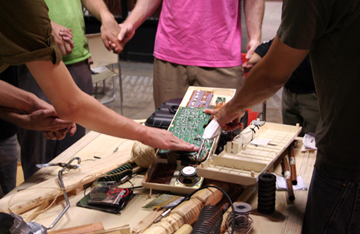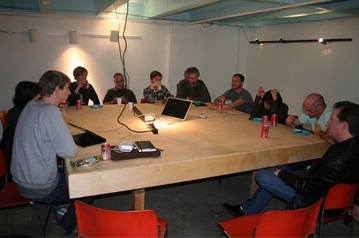Gold Leafing. Sadism & Masochism. Practical Electro-Mechanisms. The Coming Insurrection. What do these topics have in common? Perhaps with some head-scratching we could ferret out a few threads, but here’s the one I’m going to address: they are all examples of courses offered by The Public School in Los Angeles. Not to be confused with Los Angeles’ public school system, The Public School operates under the auspices of Telic Arts Exchange, a nonprofit organization nestled in amongst a stretch of contemporary commercial galleries in LA’s Chinatown. The notions of public and private have been a hot topic in our Looking at Los Angeles posts, perhaps because there is more of the latter than the former, and the arenas that are demarcated as public often fail to deliver.
The Public School, however, is true to its name and functions as a site of porous, transmutable, open and democratic educational exchanges. Anybody can propose a class. Anybody can express interest in that class. Once a critical mass of people express interest, anybody can offer to teach the class. A small committee moderates the final steps of the process, including finding an instructor and scheduling the course. However, committee members typically step down after several months, making room for new committee members to join and keeping the system as open to transformation as possible. The result, as you can see from the extensive list of courses offered, is an incredibly varied selection of subjects, ranging from pragmatic to esoteric, concrete to abstract. Yet all classes share a collaborative spirit, owing, most likely, to the democratic method employed in actualizing each course.
Developed in early 2008 as an arena for discourse related to Telic’s exhibitions, The Public School began to grow immediately. Within months, Telic co-directors Sean Dockray and Fiona Whitton decided to discontinue Telic’s long-running program of exhibitions, performances, lectures, happenings, etc. and concentrate on The Public School. Since that time, affiliate public schools have been initiated in five other cities. Dockray answered my questions via email from Brussels, where the newest arm of The Public School opened last week.

Still from "Instrument Buildathon," organized by Stephen van Dyck and Eric Lindley, 2007. Courtesy Telic Arts Exchange.
Lily Simonson: How did the focus shift from Telic’s exhibition space to the Public School?
Sean Dockray: We started the public school in our basement to be in conversation with the exhibition space (open to all kinds of conversation: agreement, contradiction, influence, etc). After about 6 months, we were nearing 5 years of exhibitions and we felt that the school was more exciting for us to do than the exhibitions…it allowed us to work with people whose practices we wanted to support (practices that were conceptual, process-based, research-oriented, or other flavors of non-object centered practice, things that weren’t widely recognized as art, and so on) in a very easy and organic way. The gallery and exhibition context, on the other hand, imposed all kinds of expectations that were rarely very useful for those practices. Even an exhibition that shows something in progress requires this level of exhibit-ability that was more of a distraction.
Also when we swapped the gallery for a school, we swapped a number of terms, which had their own effects: an exhibition maybe became a class, the audience became…students? When a student goes to a class, they go with different expectations and they are prepared to engage with the others and the subject in a different way. They are prepared to stay longer, ask questions, argue with others, etc.
We could work with projects that were still only an idea and help them come into fruition; we could work with projects that have been going on for 10 years; we could work with vague constellations of thought or people that barely amounted to a project. All of these possibilities made it exciting for us to switch models and start operating as a school.
LS: The Public School has returned to the main drag of Chung King Road (an epicenter of contemporary art galleries). How would you characterize its relationship to the art world? To Los Angeles in general?
SD: There are so many art worlds, it’s difficult to answer this question…I think the public school provides a certain kind of resource or space, maybe like a cafe or a bar or a library that allows for art and non-art, for juxtaposition of people and territories and ideas.
As for Los Angeles, that’s another tough one, because the school is always changing and so is the city, and the parts of the city that engage with the school and vice versa. And I always imagine how huge Los Angeles is, and how small our new space is, and really can’t understand the relationship when the scales are so astoundingly dissimilar.
But, I think Los Angeles has a brilliant history and current context of alternative spaces, and this has been confirmed by my time [in other cities where the] local art scenes are more or less connected to international markets, and really pale in comparison to the vitality of self-organized/self-initiated/artist-run projects. I think the public school is one part of that history and contributes to what is happening now.
The galleries here are pretty conservative and the young people and students coming out of schools and others who don’t participate solely in the commercial art market are pretty ambitious, energetic, and creative and so they just make their own contexts for doing things. Lots of space (even if it really isn’t always cheap), commercial art context, lots of materials and industries, not much state funding, and a dominant mythology that anything is possible in LA (which may not be true, but then if enough people act that way, some great things happen).
LS: The Public School has blossomed into quite a diaspora: Brussels, Chicago, Paris, Philadelphia, New York. What are the other TPS outposts like? How does place affect the quality of exchange, and the courses?
SD: I haven’t been to Chicago or Philadelphia. New York is an architecture school in collaboration with an architecture firm there called common room, as part of a fellowship (through the Van Alen Institute). Paris is through an art center called bétonsalon, located precariously within a university. Brussels is in a house given through a residency to Komplot, who is spearheading the school (t)here. I do think that the cities and the institutional contexts certainly affect the nature of proposals. How [they are affected] is a matter of conjecture. It’s difficult to get people to begin thinking about proposing the ‘unknown’ in other places: what you want to learn, a situation you want to be in but have no idea how it will go, etc. There is a lot more proposing things that they want to teach (what they already know). But I can’t say if this is cultural, or a matter of publicity. I think they are all super exciting, with different groups of brilliant people and different contexts for having the classes, different furniture, different ways of introducing people, different existing discussions. For example, I was told in Brussels there is a lot of cooking, but almost no knitting, whereas in LA there are lots and lots of relatively young people who take up knitting (and this is reflected in our class proposals). A little thing.
I am hoping that these various public schools begin to circulate between each other… if it’s just awareness at first, that’s great, but eventually people and proposals and classes. As there are more [sites for The Public School], which are also closer together, I think this is more likely. For example, Paris is an hour or so from Brussels, and so already there have been classes and people going back and forth.





Pingback: Öffentliche Google-Waves - Dijit
Pingback: newmediafix.net » Blog Archive » The Public School: news and 5 classes coming up
Pingback: Borderland › Critical Readings
Pingback: Bruce High Quality Foundation University | Art21 Blog